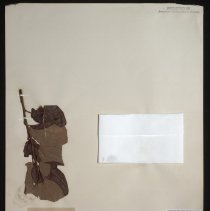Object Record
Images

Metadata
Catalog Number |
PH-LC 49 |
Object Name |
Specimen |
Title |
Ceanothus velutinus |
Other Name |
Mountain Balm |
Collector |
Meriwether Lewis & William Clark |
Date |
ca. 1805 |
Description |
The Lewis and Clark sheet is without a date and according to label data the specimen was found on the "waters of the Kooskooskie." Given the state of the fragment, and a general lack of information, we believe the collection was made in the fall of 1805. If true then most likely the plant was found somewhere along the Clearwater River in late September or early October (Moulton, 1988). (The Lewis & Clark Herbarium Digital Imagery Study Set, ANSP, 2002) On deposit at the Academy of Natural Sciences, Philadelphia |
Label |
Starting in 1803, Merriwether Lewis (APS 1803) and William Clark embarked on a 3 year expedition along the Missouri and Columbia rivers to the Pacific Coast. They collected hundreds of plant specimens to carry back to the East Coast. They pressed these plants, attached them to sheets of paper and wrapped them in oilskin to survive the long journey intact. The Snowbrush Ceanothus, Ceanothus velutinus, is a mid-size shrub native the dry regions of the Pacific Northwest and the northern Rocky Mountains. In the fall of 1805, while traveling along the Clearwater River (historically Kooskooskie) in Idaho, Lewis and Clark collected a specimen of snowbrush that had several intact leaves but no clusters of the small, white flowers that give the plant its common name. Historically, many indigenous communities along the non-coastal Northwestern United States used the plant's root bark and leaves for a variety of medicinal treatments- primarily a dermatological aid and analgesic. |
Credit line |
American Philosophical Society. Gift of Thomas Jefferson, 1805 - 1806. |
Search Terms |
19th century botany Clark herbarium Lewis nineteenth century plant specimen |
Collection |
The Lewis & Clark Herbarium |
